Art World
What Is a ‘Narrative Art Museum’? 6 Things to Expect From George Lucas’s New LA Museum
Director Don Bacigalupi lays out plans for the museum ahead of its 2022 opening.

Director Don Bacigalupi lays out plans for the museum ahead of its 2022 opening.

Sarah Cascone

After a year of planning and three proposed cities, filmmaker George Lucas’s forthcoming Lucas Museum of Narrative Art finally broke ground last month in anticipation of its 2022 opening.
It’s an exciting time for the Lucas Museum, which for years was shunted between San Francisco and Chicago—where local activists fought the project tooth and nail—before finally landing in Los Angeles in January of 2017. The museum will be located in Exposition Park, which is already home to the Los Angeles Memorial Coliseum, the California Science Center, and the Natural History Museum of Los Angeles County.
Last week the museum announced that it had purchased Norman Rockwell’s painting Shuffleton’s Barbershop (1959), one of 40 works being controversially deaccessioned by Massachusett’s cash-strapped Berkshire Museum. The sale is likely only the first of many high-profile acquisitions by the institution.
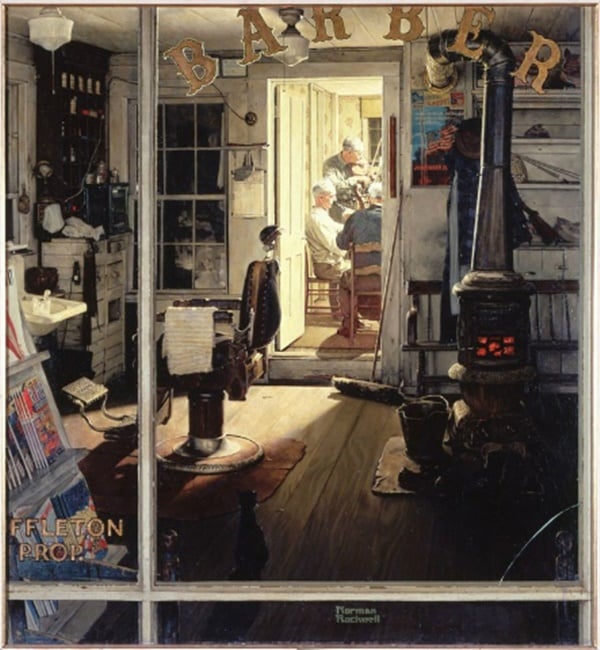
Norman Rockwell, Shuffleton’s Barbershop (1959). Courtesy of Berkshire Fine Arts.
It will also feature art and artifacts from George Lucas’s personal art collection, which is heavy on 20th-century American work and Hollywood artifacts, particularly from his beloved Star Wars franchise.
Museum designs from Ma Yansong, of the Beijing-based architectural firm MAD Architects, were unveiled in May, showing a curvaceous, spaceship-like structure that seems primed for takeoff.
We spoke with Lucas Museum director Don Bacigalupi about the building’s design, plans for the collection, and what it means to be a museum of narrative art. Here are seven take-aways from the conversation.
Biolumes from James Cameron’s Avatar (c. 2009). Courtesy of the Lucas Museum of Narrative Art.
1. The museum’s wide-ranging collection will appeal to grandparents and preteens alike.
“We celebrate works of art of all types that people actually engage with on a daily basis, and nothing could be better to help us attract a broad audience.
My 12-year-old son is much more interested in movies, graphic novels, comic books, and anime than he is in paintings and sculpture, no matter how much his father takes him to every museum in the world. The people who will come for the film materials or the comic art or the animation—whatever it is that draws people in—we want to make sure that they’re also exposed to and engaged in other types of art.
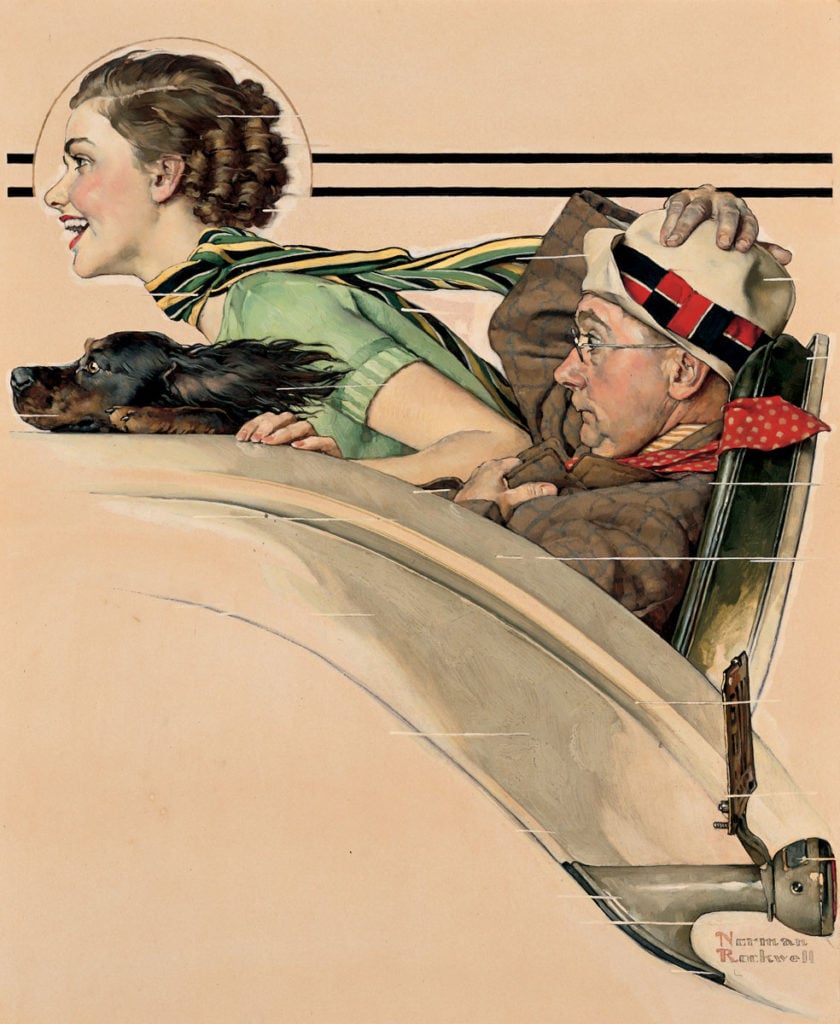
Norman Rockwell, Couple in Rumbleseat (c. 1935). Courtesy of the Lucas Museum of Narrative Art.
On the other hand, my grandmother’s generation may want to come in just for the Rockwell paintings. I want to make sure that both types of audiences encounter something very different from their existing interests, and understand that there’s a common underpinning of narrative or some theme that resonates across those disciplines.
There’s richness in that mix of audiences, the sort of social bridging that happens where multiple generations and people of diverse backgrounds are informing each other of their own passions and their own points of access. Different types of material can have a different relevance depending on the audience.”
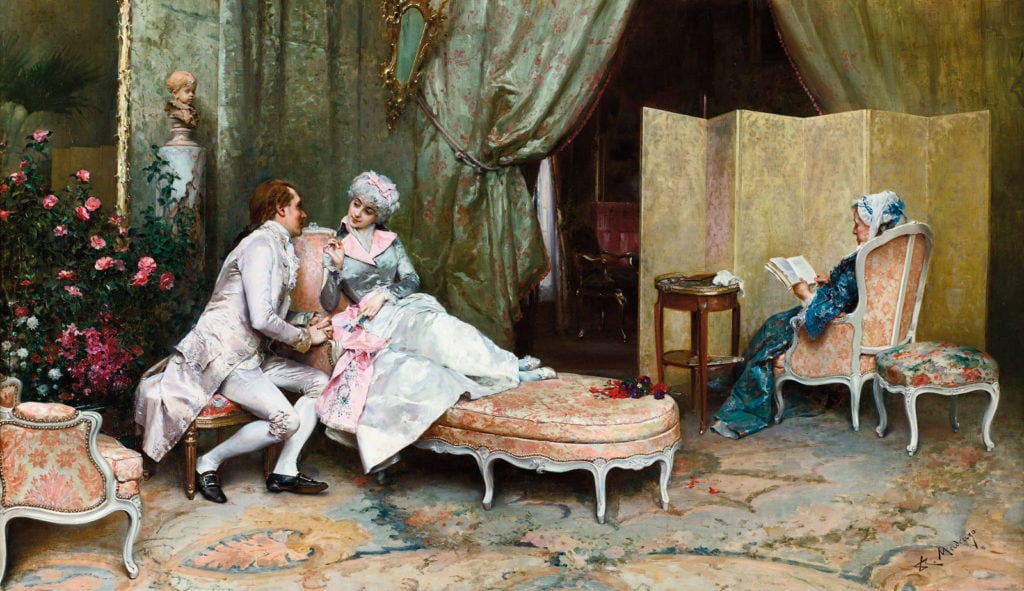
Raimundo de Madrazo y Garreta, Flirtation. Courtesy of the Lucas Museum of Narrative Art.
2. The museum won’t be boxed in by traditional concepts of what is and isn’t fine art.
“In their daily lives, people interact with all kinds of popular storytelling visual forms, most of which are maybe not what we have historically called fine art. Our purpose as a museum is to highlight and explore and celebrate the best of these forms, and to really unpack the way in which they work.
We’re really interested in this through-line of narrative, the fact that so many artists in so many cultures, times, and places have been compelled to tell stories in different mediums. Why do we have this drive and how does it work?
George Lucas often talks about the way propaganda works can activate people’s imaginations and appeal to their emotions and, often, cause people to act. Of course, propaganda has a negative connotation, but there are all kinds of ways that artists are compelling us to feel, think, or act a certain way. That’s the importance of what what we’re looking at, across boundaries, not limited by what has typically been designated as fine art or popular art or media art.”
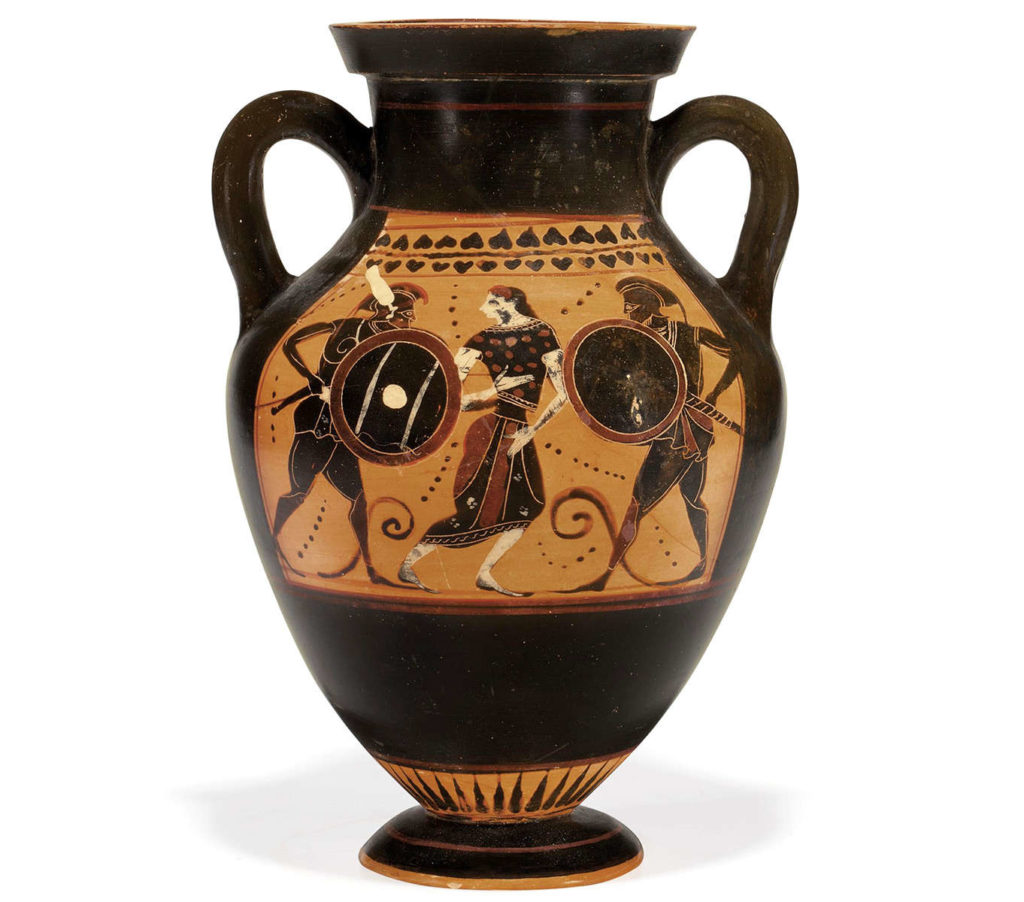
An Attic Black-Figured Amphora (c. 520 BC). Photo courtesy of the Lucas Museum of Narrative Art.
3. This is a museum envisioned by a storyteller.
“As with any founder of an institution, George is obviously very close to our project. He’s the chair of our board and his collecting passions will undoubtedly be our deepest holdings, the core of the collection on which the museum is already building. There will always be a very strong imprint of his view of narrative.
One of the ways the lenses through which George has always looked at art is with an anthropological approach; the idea that art plays an important role in societies, cultures, communities, and families by communicating stories that are meaningful, shaping our belief systems, religious views, or political understanding of the world—whatever it is.
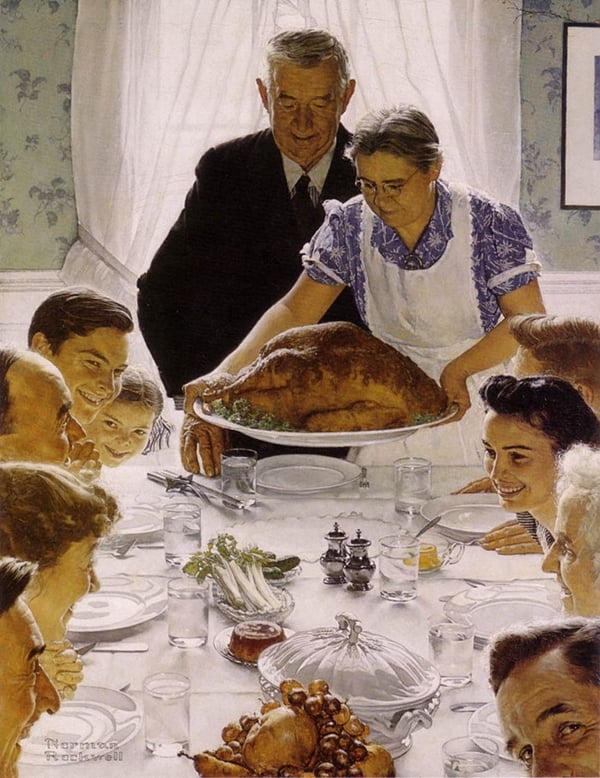
Norman Rockwell, Freedom from Want (1943). Illustration for the Saturday Evening Post. Courtesy of the Norman Rockwell Museum Collections, © SEPS, Curtis Licensing.
George will sometimes tell the story, as he did at our groundbreaking, of Norman Rockwell’s Freedom From Want painting from the “Four Freedoms” series, which we all know is the Thanksgiving dinner painting. Even if we personally experience the holiday very differently, the painting is still an icon of what we expect a Thanksgiving dinner to be. The fact that that image has been reproduced so much, particularly in the 20th century, creates a kind of connective glue that binds society together.
Art has that compelling power to bring people together around an idea or an aspiration. That is the power that we’re seeking to explore and to have our viewers be more aware of. Often, museums talk about visual literacy skills that they can impart, or critical thinking skills. Because stories are being told and sold to us all the time through visual means, we need to be thoughtful and critical and recognize the way in which they are working on us, otherwise we’re probably not as alert as we should be.”
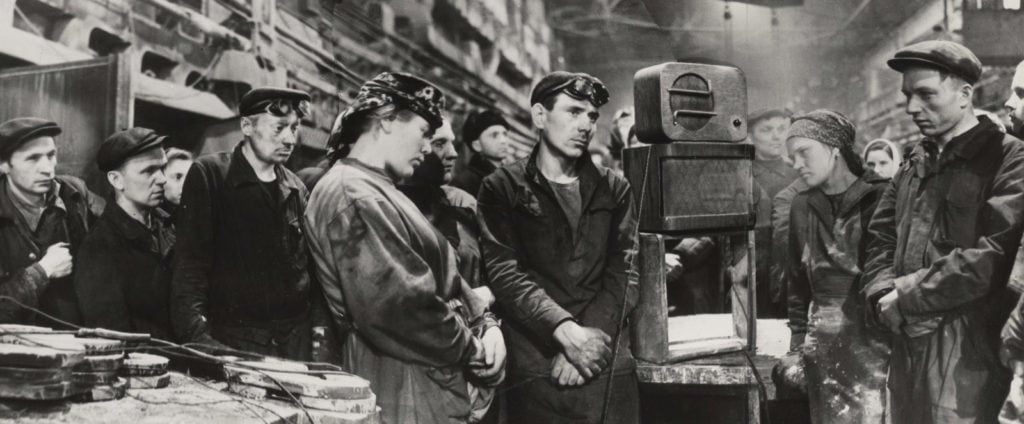
Dmitri Baltermants, The Announcement of the Death of Stalin, Dynamo Factory, Moscow, March 6, 1953. Photo courtesy of the Lucas Museum of Narrative Art.
4. Temporary exhibitions will crosspollinate with the permanent collection.
“The building has a curvilinear outline, which becomes a meandering path that one can take all around the perimeter of the fourth floor, which is dedicated to 100,000 square feet of gallery space.
It’s still very early in the process, but we’re envisioning that the galleries that ring the outer perimeter of that floor will be dedicated to the collection, which is very diverse, and features very different types of materials.

Andy Warhol, Andy2 (1985). ©The Andy Warhol Foundation for Visual Arts, Inc./Artists Rights Society (ARS), New York; Collection of the Andy Warhol Museum, Pittsburgh. Courtesy of the Lucas Museum of Narrative Art.
Within the center core of that floor are a series of temporary exhibition spaces. The notion is that as we’re developing new shows, we’ll have the opportunity to interpenetrate the collection galleries. So for instance, if you’re in a gallery that is primarily Golden Age illustrations, like Rockwell or Maxfield Parrish or Andrew Wyatt, there might be an adjacent exhibition that does a deep dive into a theme that’s developed in that collection gallery, or mixes in other art forms or styles that explore a similar subject matter—a kind of cross-pollination.
There will undoubtedly be a very lively mix. There are lots of ways to think about displaying work. Certainly the idea of looking at archetypal stories across cultures, disciplines, and media, would be ripe fodder for an exhibition or a presentation of the collection. We could also, for instance, take a monographic look at an artist’s work across different media. We have lots of space to explore.”
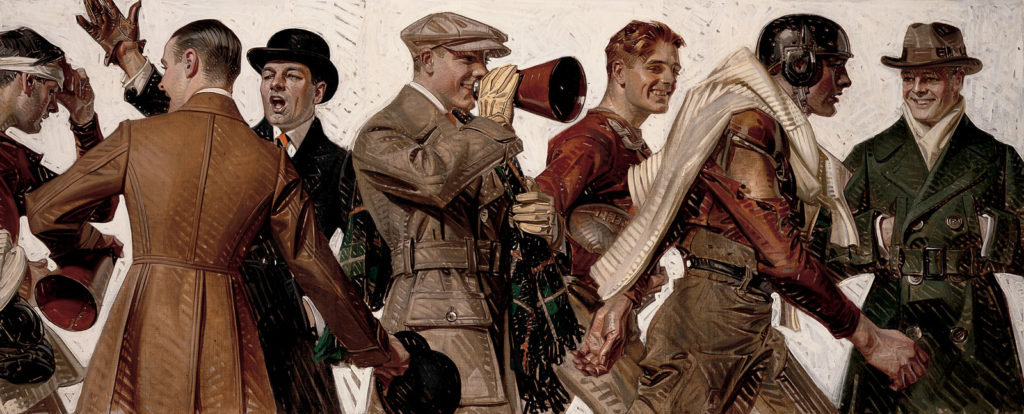
Joseph Christian Leyendecker, Football Players & Fans (c. 1920). Courtesy of the Lucas Museum of Narrative Art.
5. The museum will re-position the role of narrative art in 20th-century art history.
“We’re thinking about diversifying to include art forms that are more native to other cultures. We’re also looking to art that is maybe five centuries older, which informed the type of work we have in the collection, as well as to newer pieces that build on those traditions.
A reductive look at contemporary art says that narrative really got excluded from the story in the 20th century. In the canonical, high Modernist story, abstraction reigns and narrative sort of goes to the periphery. But in fact, art history is a very complicated thing.

Jessie, Woody, and Buzz in Toy Story 3. ©Disney/Pixar. Courtesy of the Lucas Museum of Narrative Art.
There were many artists making narratives in a variety of ways throughout Modernism and certainly in the contemporary period. We want to link that kind of work to these other forms in which we have deeper holdings.
Our strategy is to treat the core collection as a launching pad for many other explorations of narrative. That means a very robust acquisition program, looking past, present, future, and across the world!”

MAD Architects’ plans for George Lucas’s Museum of Narrative Art in Los Angeles.
6. The futuristic-looking building isn’t inspired by Star Wars.
“There are not any intentional references to Star Wars. Star Wars is a film that was set a long time ago in a galaxy far away. One of the reasons George Lucas was attracted to Ma Yansong’s design is because this building couldn’t have been designed a generation ago—couldn’t have been built even 15 years ago. It is absolutely of its moment and looking forward to the future.
All of the organic and curvilinear shapes of the building are very much about the sense of embrace that one will feel arriving at the museum. It’s this very iconic, forward-looking building that is also very attuned to its location in Exposition Park, and the fact that it is in a park—what was once 11 acres of asphalt will be 11 acres of green space!
There’s a very large pedestrian plaza through which one will enter the building lobby. It’s a very open, wide, curving, arching space, with sunlight coming thorough the oculus overhead.”
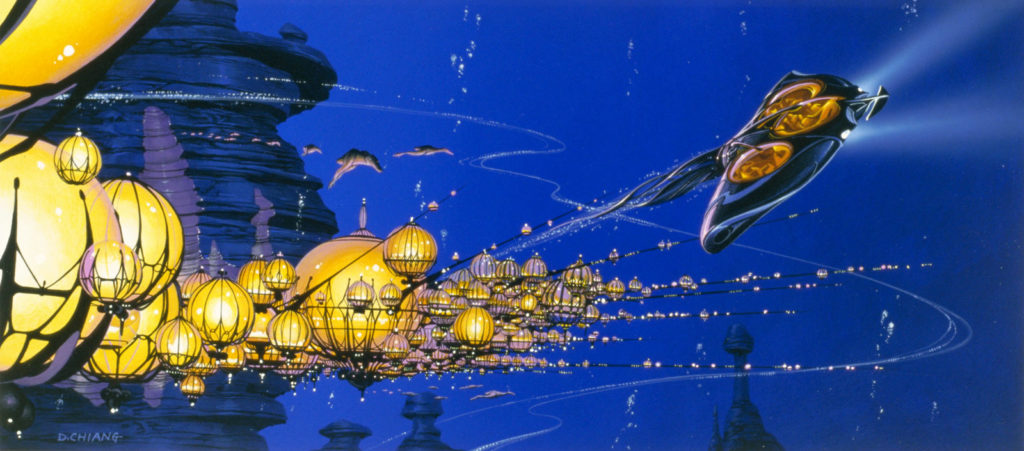
A painting of Otoh Gunga City, from Star Wars Episode I: The Phantom Menace. Courtesy of the Lucas Museum of Narrative Art.